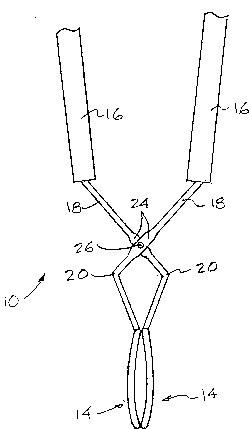Une partie des informations de ce site Web a été fournie par des sources externes. Le gouvernement du Canada n'assume aucune responsabilité concernant la précision, l'actualité ou la fiabilité des informations fournies par les sources externes. Les utilisateurs qui désirent employer cette information devraient consulter directement la source des informations. Le contenu fourni par les sources externes n'est pas assujetti aux exigences sur les langues officielles, la protection des renseignements personnels et l'accessibilité.
L'apparition de différences dans le texte et l'image des Revendications et de l'Abrégé dépend du moment auquel le document est publié. Les textes des Revendications et de l'Abrégé sont affichés :
| (12) Demande de brevet: | (11) CA 2041999 |
|---|---|
| (54) Titre français: | TENAILLES A POINTES EXCENTREES |
| (54) Titre anglais: | ANGLED TONGS |
| Statut: | Réputée abandonnée et au-delà du délai pour le rétablissement - en attente de la réponse à l’avis de communication rejetée |
| (51) Classification internationale des brevets (CIB): |
|
|---|---|
| (72) Inventeurs : |
|
| (73) Titulaires : |
|
| (71) Demandeurs : | |
| (74) Agent: | ADE & COMPANY |
| (74) Co-agent: | |
| (45) Délivré: | |
| (22) Date de dépôt: | 1991-05-07 |
| (41) Mise à la disponibilité du public: | 1992-11-08 |
| Licence disponible: | S.O. |
| Cédé au domaine public: | S.O. |
| (25) Langue des documents déposés: | Anglais |
| Traité de coopération en matière de brevets (PCT): | Non |
|---|
| (30) Données de priorité de la demande: | S.O. |
|---|
-7-
ANGLED TONGS
ABSTRACT OF THE DISCLOSURE
An apparatus is provided for grasping objects. It is
particularly useful for grasping objects on the ground with
the user in a standing position. The apparatus has
particular utility in picking up animal droppings. It
consists of two long arms with long, rigid handles and
shorter, resilient shanks that cross and are pivotally
connected to one another where they cross. Adjacent the
pivot, each shank carries an object grasping head. When the
heads are in engagement and the shanks are undeformed, the
handles diverge so that the handles can be brought together
provide considerable force for grasping a thin-walled object
such as a can, bag or the like. When the handles are brought
together, they may be held in place using a loop of thong on
one of the handles.
Note : Les revendications sont présentées dans la langue officielle dans laquelle elles ont été soumises.
Note : Les descriptions sont présentées dans la langue officielle dans laquelle elles ont été soumises.

2024-08-01 : Dans le cadre de la transition vers les Brevets de nouvelle génération (BNG), la base de données sur les brevets canadiens (BDBC) contient désormais un Historique d'événement plus détaillé, qui reproduit le Journal des événements de notre nouvelle solution interne.
Veuillez noter que les événements débutant par « Inactive : » se réfèrent à des événements qui ne sont plus utilisés dans notre nouvelle solution interne.
Pour une meilleure compréhension de l'état de la demande ou brevet qui figure sur cette page, la rubrique Mise en garde , et les descriptions de Brevet , Historique d'événement , Taxes périodiques et Historique des paiements devraient être consultées.
| Description | Date |
|---|---|
| Le délai pour l'annulation est expiré | 1998-05-07 |
| Demande non rétablie avant l'échéance | 1998-05-07 |
| Réputée abandonnée - omission de répondre à un avis sur les taxes pour le maintien en état | 1997-05-07 |
| Demande publiée (accessible au public) | 1992-11-08 |
| Date d'abandonnement | Raison | Date de rétablissement |
|---|---|---|
| 1997-05-07 |
Les titulaires actuels et antérieures au dossier sont affichés en ordre alphabétique.
| Titulaires actuels au dossier |
|---|
| CAROL E. YOUMANS |
| Titulaires antérieures au dossier |
|---|
| S.O. |